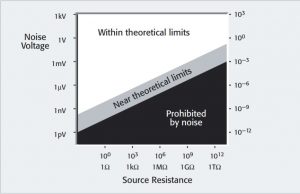The theoretical limit of sensitivity in any measurement is determined by the noise generated by the resistances present in any circuit. The voltage noise is proportional to the square root of the resistance, bandwidth, and absolute temperature. Figure shows theoretical voltage measurement limits at room temperature (300K) with a response time of 0.1 second to ten seconds. Note that high source resistance limits the theoretical sensitivity of the voltage measurement. Although
it’s certainly possible to measure a 1µV signal that has a 1Ω source resistance, it’s not possible to measure that same 1µV signal level from a 1TΩ source. Even with a much lower 1MΩ source resistance, a 1µV measurement is near theoretical limits, so it would be very difficult to make using an ordinary DMM. In addition to having insufficient voltage or current sensitivity (most DMMs are no more sensitive than 1µV or 1nA per digit), DMMs have high input bias current when measuring voltage and lower input resistance compared to more sensitive instruments intended for low level DC measurements. These characteristics cause errors in the measurement.
Given these DMM characteristics, it’s not possible to use a DMM to measure signals at levels close to theoretical measurement limits, as shown in Figure. However, if the source resistance is 1MΩ or less, or if the desired resolution is no better than 0.1µV (with low source resistance), the signal level isn’t “near theoretical limits,” a DMM is adequate. If better voltage sensitivity is desired, and the source resistance is low (as it must be because of theoretical limitations), a nanovoltmeter provides a means of measuring at levels much closer to the theoretical limits of measurement.
With very high source resistance values (for example, 1TΩ), a DMM isn’t a suitable voltmeter. DMM input resistance ranges from 10MΩ to 10GΩ— several orders of magnitude less than a 1TΩ source resistance, resulting in severe input loading errors. Also, input currents are typically many picoamps, creating large voltage offsets. However, because of its much higher input resistance, an electrometer or high impedance SMU instrument can make voltage measurements at levels that approach theoretical limits. A similar situation exists for low level current measurements; DMMs generally have a high input voltage drop (input burden), which affects low level current measurements, and DMM resolution is generally no better than 1nA. Thus, an electrometer or picoammeter with its much lower input burden and better sensitivity will operate at levels much closer to the theoretical (and practical) limits of low current measurements.
[1]Low Level Measurements Handbook – 7th Edition, Precision DC Current, Voltage, and Resistance Measurements, Tektronix
Theoretical Limits of Voltage Measurements

Under the above concepts the Low Level Measurements Group uses high standard instrumentation in order to measure:
- Very low and very high resistance measurements.
- Weak electrical voltage and current signal measurements.
and designs new equipment capable on conducting Low Level measurements.